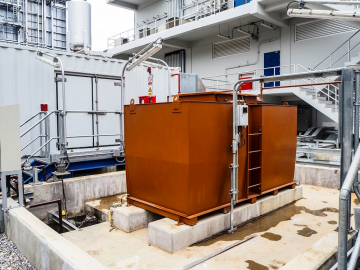This month we were excited to be able to gather over 50 EHS professionals from twenty-five of the biggest names in the tech industry for a one-day event in San Francisco, kindly hosted by Salesforce. This was our first meeting back in-person since the pandemic and it was great to see both familiar faces across our networking group and to welcome new ones. EHSxTech® represents a unique opportunity for industry professionals to collaborate and network with their peers, while exploring global regulatory updates, health and safety (H&S) practices, and Environment, Health, and Safety (EHS) trends in this rapidly changing industry.
This session focused on what the future of EHS looks like now that many businesses are returning back to “normal” operations as opposed to when COVID was the driver for all Health & Safety activities. The question now is how do EHS professionals and leaders keep their seats at the executive table and how do we pivot back to our core EHS initiatives and priorities that were sidelined during the pandemic? The workplace as we know it has changed and many companies now have hybrid operations, work-from-home employees to consider, or are returning to offices and must re-engage employees. During the event, we had breakout sessions on different topics, including emergency response, occupational health, data centers, global regulatory updates from our Inogen Alliance Associates in attendance, and the intersection of EHS and ESG.
Health and Safety as a Competitive Edge
Our host, Karl Huntzicker, VP – Global Health and Safety at Salesforce, gave a keynote on how the Health & Safety program at Salesforce demonstrates value by giving the company a competitive edge. This competitive edge is realized through five contributions their program makes: Enabling sales, driving productivity, protecting the company, building resilience and attracting/retaining top talent. To amplify the impact of their program, they put employee care at the center of all of their programs. This aligns with their company values which allows employees to further engage and create a culture where employees care about their safety and the safety of others.
Guest speaker Jenn Taylor of Roku also spoke about beginning the work of building up EHS programs in her new position at the company, while bringing an incredible depth of background at other companies in this space. Taylor is looking to build EHS programs using Total Worker Health concepts. Key topics now in considering Total Worker Health have been mental health, home community, workplace culture, and how to measure these new concepts to show value to executives. She sees EHS as the protector of people and holistic health and views the “H” in EHS as “Human.” This means approaching EHS programs from a relationship and caring aspect but also considering “Human Resources” with synergies and collaboration between departments and programs. There is opportunity through the EHSxTech networking group, Taylor attested, especially during COVID with reaching out to industry peers to hear what’s working and what’s not and helping each other out during these challenging times.
Cross-Functional Collaboration With EHS
During the panel discussion, participants reflected on the pandemic and noted that it brought leaders from every function together to deal with top concerns of health & safety. Teams in EHS had to be versatile – everything they did before COVID stopped and they had one main focus. There was no way for EHS teams to manage it by themselves so having a seat at the executive table brought value, trust, and visibility. Leaders in EHS have been smart about maintaining this elevated position for the future and looking at new synergies and cross-functional collaboration.
“We look at where there is not EHS integrated within a department and ask how we can link our team in. Now, there is a full company Risk Model. Compliance is everywhere and we built EHS, not only as a function, but as a Second Line of Defense - partnering with every relevant leader and are using scenarios in their areas to build out top risks together,” Joe Clark, Head of Governance, Risk Management & Compliance, Google.
Banu Gajendran, Director of Global Health & Safety Governance at VMware looks at sustaining synergies for holistic health and safety governance and critiquing the “So what?” value add of the program offerings. Working with HR and other key stakeholders in the business to drive cross-functional synergies in managing total worker health is imperative. “Historically, H&S was being perceived as purely a compliance function but by partnering with HR & transforming the traditional H&S delivery model, the business benefits of managing health and safety holistically can be shown.”
The panel discussed how there is an opportunity to look at what’s next and be more prepared next time. Some are looking at an Occupational Health and Safety (OHS) position to maintain occupational health and monitor risks. It’s a duty of care to employees to keep processes ready to react when needed. It’s looking at moving from occupational health to a health management program. A common thread seems to be blurred lines of ownership internally, but this creates an opportunity for EHS to step up to the plate, take ownership, and take the initiative to lead and expand current programs.
Emergency Response Management & the Hybrid Workforce
With today’s mixed workforce of in-office, hybrid, and fully remote across the varied landscape of technology industry settings (manufacturing, data centers, offices, transportation), the topic of how to manage emergency response programs becomes even more important and more complex. These programs not only keep employees safe, but also the community, and the public that may exist within these spaces. There was acknowledgement that flexibility is now key in allowing different teams in different settings to create their own agreements and unique plans for disaster planning and safety protocols. Utilizing several different channels of communication should also be a consideration during emergencies with Slack, emails, texts, or other tools that are commonly used within the company. Some companies are now providing home emergency kits and home emergency preparedness books or plans to ensure safe workplaces wherever employees are located.
EHS teams striving to increase employee engagement in EHS are looking at areas of employee interest to identify relevant topics. One popular avenue is a focus on pets. Pet safety training -- whether it’s pet CPR or emergency response for pets, these topics are layered on the existing trainings – generating new interest. Other companies have gotten creative with who is available in the office or workspaces to act as ERTs (emergency response team members) such as adding on to janitor or facility managers’ contracts and duties.
In Closing
The EHS professionals in attendance took full advantage of the opportunity to network. They found it reassuring to share with peers and learn that no one company has it all figured out. They are all on a journey helping lead their companies to success, by creating healthy and productive work environments for employees. A message that resonated at the end of the meeting was, “How can we give others a seat at our table” and encourage engagement? How can we use our EHS platform to make a difference in the lives of the employees we work with? These are the thought provoking questions that will drive the next evolution of EHS within the Technology Industry.
Want more news and insights like this?
Sign up for our monthly e-newsletter, The New Leaf. Our goal is to keep you updated, educated, and even a bit entertained as it relates to all things EHS and sustainability.
Have any questions?
Contact us to discuss your environment, health, safety, and sustainability needs today.






